
|
Aneng's Model 683 belongs to the very latest generation of handheld multimeters that completely resemble a smartphone and are operated in the same way via the touch-screen. |
Introduction to model 683 from Aneng
Type, manufacturer and prices
Almost all Chinese mail order companies offer this multimeter as 'model 683' of the Aneng brand. Prices range around thirty euros. At the time of this test, you paid € 26.30 for it at Banggood and € 26.44 at the cheapest provider on AliExpress. Our sample was provided free of charge for a test by Banggood.
The main features of the Aneng-683
The distinguishing feature of this multimeter is that it is equipped with a touch screen as large as a smartphone, so the five control buttons are not present as such, but as on-screen icons. The device looks completely like your phone, the only obvious difference is that this meter is much thicker than a phone.
The display contains the standard two numeric and one analog displays. The numeric displays have four digits and have a display range up to 5999, except for measuring frequencies where the range is extended to 9999.
The meter is powered from a built-in 3.7 V lithium battery with a capacity of 2,800 mAh. You can charge this battery via a USB-C connector on the back from a standard 5 V adapter. This connector is behind a splash-proof cover.
The meter is called 'smart' because it can determine what you want to measure. A nice advertising slogan, but not entirely accurate. It automatically switches between resistance, voltage and current, but for measuring capacitors, frequencies and temperatures you still have to intervene. Of course, the range is also selected automatically, which you can't even choose manually.
The meter comes in a red or black rubber protective case and with a handy carrying case.
 |
| The front and back of the Aneng 683 multimeter. (© 2023 Jos Verstraten) |
Aneng's Model 683 viewed from all sides
The picture below shows the five main views of this multimeter. On the top is a white LED and the location of the 'NCV' sensor is indicated by a pictogram. This sensor allows you to detect voltage carrying wires in the wall. In the bottom, you can see the three sockets for 4 mm banana plugs labeled 'mA/A', 'COM' and 'V/Ohm/°C/F'. On the left side is a red push button to turn the device on and off.
The display shows all indications that, in one combination or another, may appear on the screen. The five touch buttons are shown in a green frame:
- Live/NCV:
Function for detecting the live wire in wall outlets and voltage carrying wires in the wall. - °C/°F:
Function for measuring temperatures in °C or °F with the supplied thermocouple. - Auto/SELECT:
- Allows you to disable the smart function and select the desired measurement function by key presses.
- HOLD/Torch:
Freezes the measured value on the display and turns the white LED on or off. - Cap:
Function for measuring capacitors.
 |
| Five views of the multimeter 683 from Aneng. (© 2023 Jos Verstraten) |
The scope of delivery
The multimeter comes in an unbranded cardboard box containing:
- The meter itself.
- A handy carrying case.
- A rubber protective cover, red or black of your choice.
- The two well-known Chinese test leads of one meter length.
- A very inexpensive one-meter thermocouple lead.
- A USB-C to USB-A charging cable of 45 cm.
- A miniature manual in Chinese and English.
On the product page of some vendors, including Banggood, there is a picture promising a lot of things that were not in the package! These include four crocodile clips, two extension cords, two extra measuring pens and some other little frills. There is no way those fit into the cardboard box, let alone the carrying case that crams all the attributes! So this photo is misleading and shows something that is not delivered!
 |
| The scope of delivery of our Aneng-683 multimeter. (© 2023 Jos Verstraten) |
The manual
We have scanned the English version of this booklet and saved it for you on our account on archive.org:
The specifications of the 683 from Aneng
According to the manufacturer, this multimeter has the following specifications:
According to the manufacturer, this multimeter has the following specifications:
- Display numeric: 2 x up to 5999 counts or 9999 counts
- Display analog: 1 x bargraph with 60 segments
- Sampling: 3 samples/s
- Measuring ranges DC voltage: 6 V ~ 60 V ~ 600 V ~ 1,000 V
- Accuracy DC voltage: ±(0.5 % + 3) ~ ±(0.8 % + 10)
- Measuring ranges AC voltage: 6 V ~ 60 V ~ 600 V ~ 750 V
- AC voltage accuracy: ±(0.8 % + 3) ~ ±(1.0 % + 10)
- Measurement principle of AC voltage: RMS
- AC voltage frequency range: 50 Hz ~ 1 kHz
- Input sensitivity voltage measurement: 0.8 V
- Input resistance voltage measurement: 10 MΩ
- Measuring range DC current: 600 mA ~ 10 A
- Accuracy DC current: ±(1.0 % + 5) ~ ±(2.5 % + 10)
- Measuring range AC current: 600 mA ~ 10 A
- Accuracy of AC current: ±(1.0 % + 5) ~ ±(2.5 % + 10)
- Protection of current measurement: 20 A glass fuse
- Resistance measurement ranges: 600 Ω ~ 6 kΩ ~ 60 kΩ ~ 600 kΩ ~ 6 MΩ ~ 60 MΩ
- Resistance accuracy: ±(0.8 % + 3) ~ ±(2.5 % + 5)
- Measuring ranges capacitor: 60 nF ~ 600 nF ~ 6 μF ~ 60 μF ~ 600μF
- Measuring ranges capacitor: 6 mF ~ 60 mF
- Measuring ranges capacitor: 6 mF ~ 60 mF
- Accuracy capacitor: ±(4.0 % + 20) ~ ±(5.0 % + 5)
- Conductance voltage diode measuring range: 3.2 V
- Measuring current through diode: 1 mA
- Limit value of conductivity measurement: 50 Ω
- Open circuit voltage conductivity measurement: 1.0 V
- Measuring range frequency: 10 Hz ~ 100 Hz ~ 1,000 Hz ~ 10 kHz
- Measuring range frequency: 100 kHz ~ 1,000 kHz
- Measuring range frequency: 100 kHz ~ 1,000 kHz
- Accuracy frequency: ±(0.8% + 3)
- Measuring range temperature: -40 °C ~ +300 °C
- Temperature accuracy: ±(1.0% + 4)
- Power off time: 15 min
- Voltage protection input: 1 kVdc or 750 Vac
- Power supply: 3.7 V ~ 2,800 mAh lithium battery
- Dimensions: 150 mm x 75 mm x 24 mm
- Weight: 180 g
Opening the case
After removing the rubber protective cover, you will find that the two parts of the housing are connected by only four small screws. After removing these screws, you can open the multimeter like the two half shells of an oyster. One 'shell' contains the lithium battery, and the other 'shell' is completely filled with the PCB. There are only four wires in sight. Two connect the battery to the PCB, the other two go to the backlight plate that sits behind the display.
The electronics in the Aneng-683
Opening the case
After removing the rubber protective cover, you will find that the two parts of the housing are connected by only four small screws. After removing these screws, you can open the multimeter like the two half shells of an oyster. One 'shell' contains the lithium battery, and the other 'shell' is completely filled with the PCB. There are only four wires in sight. Two connect the battery to the PCB, the other two go to the backlight plate that sits behind the display.
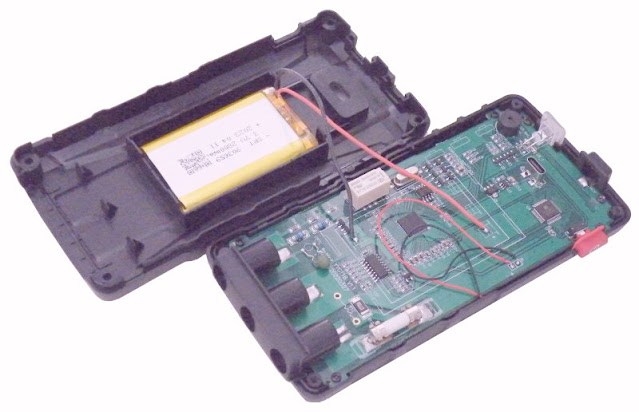 |
| Inside the Aneng-683 multimeter. (© 2023 Jos Verstraten) |
The PCB in detail
The PCB is attached to the housing with six miniature screws. Under the PCB is the backlight plate of the display and the display itself. The connections between the PCB and the display are made with conductive rubber contact strips.
We provide some details about the electronics on this PCB presented in the photo below. On the top right you can see the 4 mm socket 'mA/A' for the current input. This is divided into two parts that make contact the moment you insert a banana plug into the input. This way, the meter knows you want to measure a current and the electronics automatically enable this measurement function. You can see that a standard 5 mm by 20 mm fuse is placed on the PCB. It is worth noting that the left fuse holder can be soldered slightly to the left. The fuse can then be replaced by a 6.3 mm by 25 mm fuse. These have a higher voltage range of 250 V and in addition, you can obtain the much better HRC types in this range of fuses. Also, the current sensor resistor R12, now implemented as an SMD resistor, can be replaced with a larger non-SMD one. Apparently, the PCB is designed for both a cheap model of multimeter and a slightly more expensive model that better meets international specifications in terms of protection class and protection.

Below the lower socket 'V/Ohm/°C/F' you can see the two MELF resistors R6 and R6A of 5 MΩ that would fix the input resistance when measuring voltages to the specified 10 MΩ. However, also connected to this input socket is a series circuit of three SMD resistors R9A, R9B and R9C of 300 kΩ. There is no way to figure out where this circuit goes, but it is clear that this 900 kΩ connected to the input raises doubts about the specified input resistance of 10 MΩ. We shall see!
The protection is standard with a PTC, the green part, and two transistors to the left of the MELF resistors.
 |
| The PCB of the Aneng-683 multimeter. (© 2023 Jos Verstraten) |
On the top left, you can see the power switch with U4, an AiP16C23 chip, below it. That's an LCD controller from Wuxi I-CORE Electronics that controls traffic to and from the display. To the left of this chip, a metal plate protrudes a few millimeters from the PCB. That is the 'sensor' that is supposed to pick up the 50 Hz electromagnetic field present around voltage carrying lines in the wall.
To the right of the USB-C connector is U3, an SMD chip labeled 57cL. That appears to be the SMD version of the CL4057A, a lithium battery charger and controller. Above the 4 MHz crystal is U2, an HE24C02. That's a 2 kb serial EPROM from HuaHong ZealCore. This is probably where the multimeter's individual calibration values are stored. In the center of the PCB is an unrecognizable chip U6. This will no doubt be a dual ADC that takes care of the entire control and execution of the various measurement functions. Further to the right is another 16-pin chip U5, also made unidentifiable. Next to this chip are a lot of resistors and it is obvious that this IC is a CMOS switch that plays an important role in automatically selecting the best measurement range.
Introductory note
In the following tables, adjustment values of a voltage or current source are listed in the leftmost column. You should not regard these as absolutely accurate and thus not use them to judge the accuracy of the Aneng-683. That is what the right-hand columns with comparative measurements with our much better laboratory equipment are for.
Measuring DC voltages
Here we use our NPS-1601 power supply as the source. To measure 50 V, it is connected in series with a GVDA power supply. The results are summarized in the table below. This shows that the Aneng-683 gives almost the same readouts as our Fluke 8842A. Neat! The only weakness of the meter in these measurements is that voltages smaller than about 0.4 V are not recognized by the automatic measurement system and the display claims that a resistor is connected to the inputs.
Testing the Aneng Model 683
Introductory note
In the following tables, adjustment values of a voltage or current source are listed in the leftmost column. You should not regard these as absolutely accurate and thus not use them to judge the accuracy of the Aneng-683. That is what the right-hand columns with comparative measurements with our much better laboratory equipment are for.
Measuring DC voltages
Here we use our NPS-1601 power supply as the source. To measure 50 V, it is connected in series with a GVDA power supply. The results are summarized in the table below. This shows that the Aneng-683 gives almost the same readouts as our Fluke 8842A. Neat! The only weakness of the meter in these measurements is that voltages smaller than about 0.4 V are not recognized by the automatic measurement system and the display claims that a resistor is connected to the inputs.
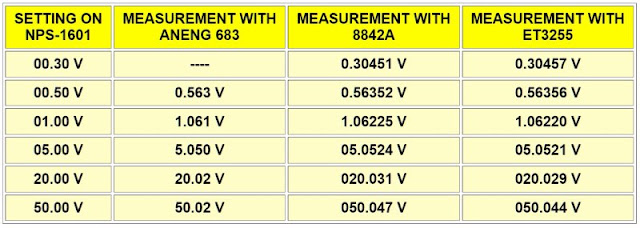 |
| Accuracy in DC voltage measurements. (© 2023 Jos Verstraten) |
Determining the input resistance
When discussing the electronics, we already wrote down our doubts about the specified input resistance of 10 MΩ. The three resistors of 300 kΩ going somewhere from the input socket suggest that this value might be over-specified. To check this, we measure a DC voltage with and without a series resistor of 1 MΩ. Without this resistor, the Aneng-683 measures a voltage of 16.37 V. With the resistor in series, the measured value drops to 7.39 V! That could never happen if the input resistance were equal to 10 MΩ. A simple calculation shows that the real input resistance of the meter is only 822 kΩ! Repeating this measurement with voltages of about 30 V and 2 V yields the same results: 821 kΩ and 827 kΩ.
An input resistance of less than 1 MΩ is out of date and far too low even for this digital meter with a resolution of only 1 mV or 10 mV.
Measuring 50 Hz AC voltages
We use a variac connected to the mains voltage. In this way we can also assess the upper range of 600 V. Note that the data in the first column are the voltages displayed on the small analog meter on the variac and are very inaccurate guide values.
Measuring 1 kHz AC voltages
Modern multimeters have such a wide frequency range that they are also useful for measuring small signal voltages, for example in audio amplifiers. So we generate some small AC voltages with a frequency of 1 kHz with our function generator DG1022 and measure them with the Aneng-683 and with our ET3255. For small voltages, the Aneng-683 fails again. Only at half a volt a reliable stable result appears on the display. Again a consequence of the so-called 'smart' function?
Measuring DC currents
We build a series circuit of a DC power supply, some resistors, the Aneng-683 and the ET3255. By varying the output voltage of the power supply and switching the resistors on and off, we apply eight currents with target values from 1 mA to 5 A to the circuit. The measurement results are again summarized in the table below. Again, the Aneng-683 fails to measure small values.
Measuring resistors
For this test we have at our disposal a set of resistors with a tolerance of ±0.1 %. As reference meters we obviously use our 8842A from Fluke and our ET3255 from East Tester. These meters use a four-wire kelvin probe, which is not possible with the Aneng-683. The results are again summarized in a table.
Measuring capacitors
Thanks to a set of five accurate capacitors with a tolerance of ±1 %, we can also determine the accuracy of the Aneng-683 when measuring capacitors. Above 1 μF, we measure ordinary electrolytics from our stock. As a reference meter we use East Tester's ET4401 with an accuracy of ±0.2%.

Some electrolytics have a large leakage current and the capacitance of such an electrolytic is measured with an error that can be tens of percent. A true RLC meter, such as East Tester's ET4401, measures the capacitance of the electrolytic capacitor by applying a small 120 Hz sine wave on a DC voltage across the capacitor and measuring the alternating current through the part.
Measuring frequencies
As a source, we use Rigol's DG1022 function generator, set to sinusoidal output. We immediately determine the sensitivity, the voltage at which the Aneng-683 measures a stable frequency. We read that as an rms value on the display of the function generator.
Measuring temperatures
Testing accuracy when measuring temperatures is a tricky business. After all, that accuracy depends not only on the meter itself, but also on the applied thermocouple and the way the temperature is measured. We have a UT320A thermometer from UNI-T with its own thermocouple. The accuracy of this meter is specified as ±(0.5% + 1), that of the supplied thermocouple ± 2 °C.
The 'Live' and 'NCV' functions
We have mixed feelings about this multimeter. The device looks modern and will no doubt appeal to a youthful audience, raised with the smartphone stuck in the hand. That what the meter can measure it mostly measures accurately, as evidenced by the various tables in our test. However, that the Aneng-683 is unable to measure small voltages or currents is such a major drawback that we would never purchase this instrument ourselves.
Measuring 50 Hz AC voltages
We use a variac connected to the mains voltage. In this way we can also assess the upper range of 600 V. Note that the data in the first column are the voltages displayed on the small analog meter on the variac and are very inaccurate guide values.
 |
| Accuracy in 50 Hz AC voltage measurements. (© 2023 Jos Verstraten) |
Measuring 1 kHz AC voltages
Modern multimeters have such a wide frequency range that they are also useful for measuring small signal voltages, for example in audio amplifiers. So we generate some small AC voltages with a frequency of 1 kHz with our function generator DG1022 and measure them with the Aneng-683 and with our ET3255. For small voltages, the Aneng-683 fails again. Only at half a volt a reliable stable result appears on the display. Again a consequence of the so-called 'smart' function?
 |
| The accuracy at 1 kHz AC voltage measurements. (© 2023 Jos Verstraten) |
Measuring DC currents
We build a series circuit of a DC power supply, some resistors, the Aneng-683 and the ET3255. By varying the output voltage of the power supply and switching the resistors on and off, we apply eight currents with target values from 1 mA to 5 A to the circuit. The measurement results are again summarized in the table below. Again, the Aneng-683 fails to measure small values.
 |
| Accuracy in direct current measurements. (© 2023 Jos Verstraten) |
Measuring resistors
For this test we have at our disposal a set of resistors with a tolerance of ±0.1 %. As reference meters we obviously use our 8842A from Fluke and our ET3255 from East Tester. These meters use a four-wire kelvin probe, which is not possible with the Aneng-683. The results are again summarized in a table.
 |
| The accuracy in resistance measurements. (© 2023 Jos Verstraten) |
Measuring capacitors
Thanks to a set of five accurate capacitors with a tolerance of ±1 %, we can also determine the accuracy of the Aneng-683 when measuring capacitors. Above 1 μF, we measure ordinary electrolytics from our stock. As a reference meter we use East Tester's ET4401 with an accuracy of ±0.2%.
As could be expected, large errors arise when measuring electrolytics. This is a consequence of the fact that when measuring capacitors with multimeters, a constant current is passed through the capacitor and measured how long it takes until the discharged capacitor is charged to a certain voltage. That charging time is directly proportional to the capacitance of the component. However, this method does not take into account the leakage current of an electrolytic capacitor that consumes part of the charging current. As a result, the component takes longer to charge and the meter measures a larger capacitance than intended.

Some electrolytics have a large leakage current and the capacitance of such an electrolytic is measured with an error that can be tens of percent. A true RLC meter, such as East Tester's ET4401, measures the capacitance of the electrolytic capacitor by applying a small 120 Hz sine wave on a DC voltage across the capacitor and measuring the alternating current through the part.
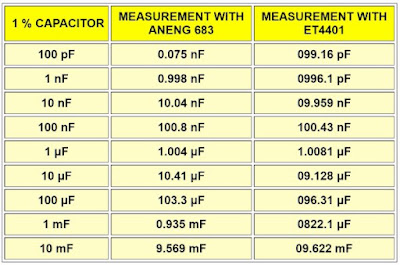 |
| The accuracy in capacitor measurements. (© 2023 Jos Verstraten) |
Measuring frequencies
As a source, we use Rigol's DG1022 function generator, set to sinusoidal output. We immediately determine the sensitivity, the voltage at which the Aneng-683 measures a stable frequency. We read that as an rms value on the display of the function generator.
 |
| The accuracy in frequency measurements. (© 2023 Jos Verstraten) |
Measuring temperatures
Testing accuracy when measuring temperatures is a tricky business. After all, that accuracy depends not only on the meter itself, but also on the applied thermocouple and the way the temperature is measured. We have a UT320A thermometer from UNI-T with its own thermocouple. The accuracy of this meter is specified as ±(0.5% + 1), that of the supplied thermocouple ± 2 °C.
We cool a large heat sink and a 100 W wire-wound resistor in the freezer. We clamp the tips of the two thermocouples, lubricated with cooling paste, close together between the heatsink and the 100 W resistor. In this way, the two thermocouples become equally hot with high probability. The 100 W resistor is heated via a power supply. We note the reading on the Aneng-683 at the time the UT320A indicates a multiples of ten temperature. The results are again summarized in the table below. The measured temperatures are, miraculously, almost identical!
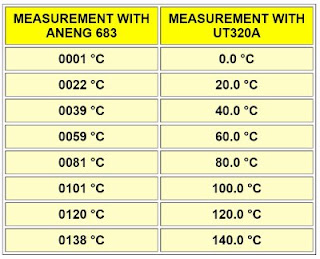 |
| The accuracy in temperature measurements. (© 2023 Jos Verstraten) |
The 'Live' and 'NCV' functions
We are never very happy about these functions that every modern multimeter has. This is also the case with the Aneng-683. The sensitivity in detecting voltage carrying wires in the wall is not very high and the positioning is not very accurate. Detecting the live in a wall outlet does work well, but we still prefer the old-fashioned voltage detector with neon lamp and series resistor.
In the picture below you can see, from left to right:
- The display in 'NCV' mode when detecting voltage carrying lines in the wall.
- The display in the 'Live' mode when measuring a live contact.
- The display in the 'Live' function when measuring a neutral contact.
 |
| The display in 'NCV' and 'Life' measurements. (© 2023 Jos Verstraten) |
Our opinion on the Aneng-683
We have mixed feelings about this multimeter. The device looks modern and will no doubt appeal to a youthful audience, raised with the smartphone stuck in the hand. That what the meter can measure it mostly measures accurately, as evidenced by the various tables in our test. However, that the Aneng-683 is unable to measure small voltages or currents is such a major drawback that we would never purchase this instrument ourselves.
About the display nothing but good, large, well lit and thus easy to read.
We assume that the dramatically low input resistance of less than 1 MΩ is a result of the automatic switching, the so praised smartness of this meter. If that is indeed the case, we find this 'smart' feature to be a disadvantage rather than an advantage. It may be due to our age, but we still prefer a multimeter where the user has to manually set the measurement function. Constantly jumping to 'ohm' in the automatic measuring function if you do not measure voltage for a moment becomes irritating after a while.

(Banggood sponsor ad)
Aneng model 683 smart multimeter
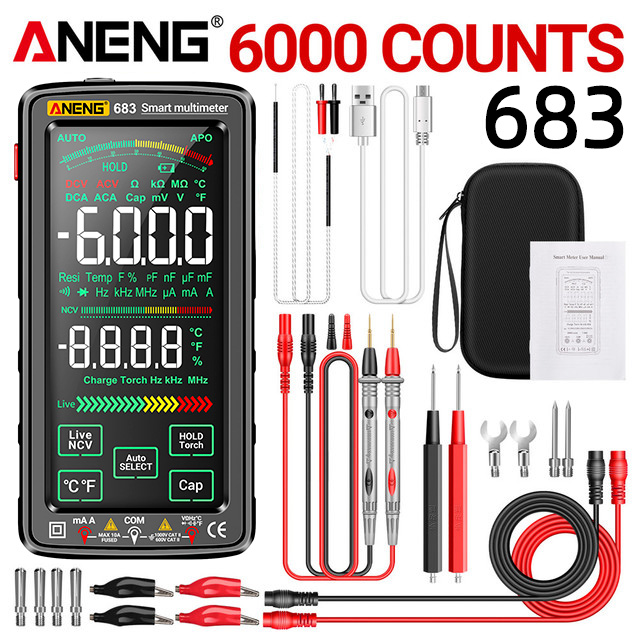

Aneng model 683 smart multimeter
